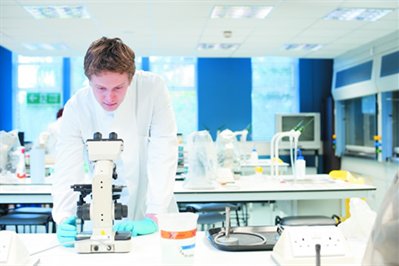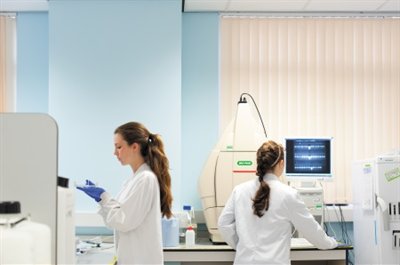Teaching Lab Resource
The School of Life Sciences has teaching laboratories on University Park Campus and in the Medical School. All teaching laboratory resources can be viewed on one of the University Open Days.
University Park
 The Teaching Laboratories on University Park are configured for maximum flexibility in accommodating a diverse range of practical, workshop and examination sessions. Facilities comprise four laboratories, two of 80 student places and two of 45 student places. All four laboratories have audio visual equipment installed with hearing loop, microphone facility and computer. With LCD projectors which are able to project Microscope & Computer images on to a large screen, the AV equipment is interconnected between all four labs, allowing combinations of labs to be used simultaneously. Each laboratory is well accommodated with a full range of both fixed and mobile equipment. Equipment includes fume cupboards; stereo and high power microscopes; Spectrophotometers and computers for data logging.
The Teaching Laboratories on University Park are configured for maximum flexibility in accommodating a diverse range of practical, workshop and examination sessions. Facilities comprise four laboratories, two of 80 student places and two of 45 student places. All four laboratories have audio visual equipment installed with hearing loop, microphone facility and computer. With LCD projectors which are able to project Microscope & Computer images on to a large screen, the AV equipment is interconnected between all four labs, allowing combinations of labs to be used simultaneously. Each laboratory is well accommodated with a full range of both fixed and mobile equipment. Equipment includes fume cupboards; stereo and high power microscopes; Spectrophotometers and computers for data logging.
Access to the equipment for students is high. The labs are supported by a dedicated Teaching Technical Team responsible for all preparations and setup.
The labs facilitate an array of classes including microbiology, parasitology, animal behaviour, immunobiology, genetics, and animal physiology amongst others.
Medical School
 Similar to those on University Park campus, the Teaching Laboratories on C Floor in the Medical School were designed for maximum flexibility in accommodating a diverse range of practical, workshop and examination sessions. The accommodation comprises two laboratories with a capacity of 120 student places, and one laboratory with a capacity of 100 student places with high-bench accommodation suitable for "wet" practical work. There is also a 204 place histology / human physiology laboratory with low benches.
Similar to those on University Park campus, the Teaching Laboratories on C Floor in the Medical School were designed for maximum flexibility in accommodating a diverse range of practical, workshop and examination sessions. The accommodation comprises two laboratories with a capacity of 120 student places, and one laboratory with a capacity of 100 student places with high-bench accommodation suitable for "wet" practical work. There is also a 204 place histology / human physiology laboratory with low benches.
The histology laboratory has full audiovisual provision which has recently been upgraded and this includes data projectors and ceiling-mounted monitors for microscopy demonstration. Each student has access to a microscope and slide sets and there are laptop PCs for viewing histology images and for general IT teaching. The low-bench configuration also allows this laboratory to be utilized for human physiology practicals.
The high-bench laboratories are used for teaching a variety of practical subjects. Although the high-bench configuration is ideally suited to biochemistry, pharmacology, microbiology and haematology teaching, there is sufficient space to accommodate human physiology practical sessions and Objective Structured Clinical Examinations (OSCEs). The two larger high-bench laboratories have full audiovisual provision, including data projectors. All of the laboratories are equipped with movable, sound-proof partitions allowing them to be sectioned into smaller areas for small-group teaching, seminars and workshops.